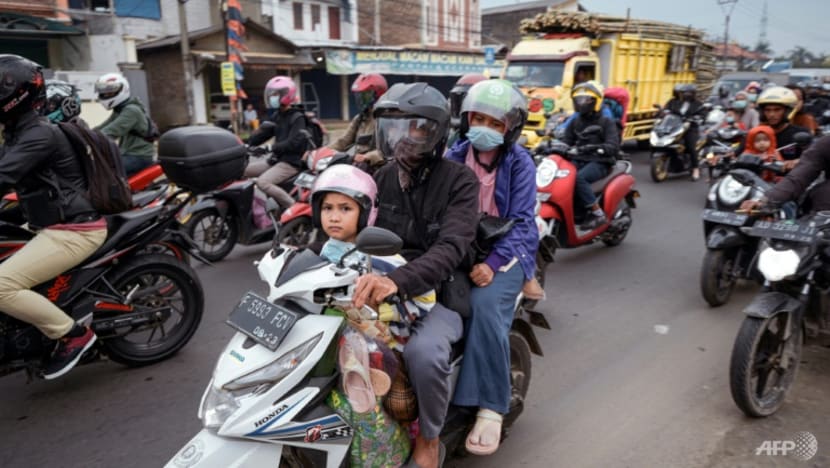CNA Explains: Why Indonesia's inflation rate has jumped to a 7-year high
The country's inflation rate was 4.94 per cent in July, the highest in seven years. The underlying factors include the low supply of commodities, high prices of imported materials and the Ukraine war.

JAKARTA: Indonesia’s inflation rate has continued to climb, reaching 4.94 per cent year-on-year in July.
The July figure is the country’s highest inflation rate since October 2015. Back then, it was 6.25 per cent.
This comes amid soaring food and energy prices globally as well as crop failures domestically, according to Mr Margo Yuwono, head of the Indonesian statistics agency.
“Global commodity prices, as well as some situations that occured domestically such as rainfall and several government policies related to energy policy, have affected our inflation in July 2022,” said Mr Yuwono on Aug 1 when he announced the latest inflation rate.
He pointed out that the major contributors to rising inflation include hikes in the prices of chillies and shallots as a result of crop failures amid recent heavy rainfall.
Higher airfares and cost of household fuel were also among the factors leading to higher inflation, said Mr Yuwono.
On the ground, people have been feeling the pinch. Many food vendors are left with little option but to raise their prices. Some have also opted to use less sambal for the time being, as chillies and shallots, which are key ingredients of the sauce, are more expensive now.
In January, Indonesia’s inflation rate was 2.18 per cent. By April, it reached 3.47 per cent.
In May, it increased slightly to 3.55 per cent before climbing to 4.35 per cent in June.
The June and July figures are above the central bank’s inflation rate target of between 2 per cent and 4 per cent.
Analysts interviewed by CNA said the current inflation rate is brought about by an accumulation of several factors in the past few months.
Looking ahead, they expect the inflation rate to continue edging upwards.
LOW COMMODITY SUPPLY AMID HIGH DEMAND
Mr Mohammad Faisal, the executive director of think tank Center of Reform on Economics (CORE) Indonesia, told CNA that the higher inflation rate was triggered by an overall low supply of commodities amid high demand.
CORE Indonesia’s research areas include the economy, industry, trade, regional development and public policy.
He explained that the supply chains of various commodities have been disrupted due to the global situation. Domestically, there were disruptions in production such as crop failures in chillies and shallots which are seasonal.
At the same time, there is high overall demand since COVID-19 restrictions have been eased this year, resulting in higher mobility.
“If the mobility (of the people) is high, the demand for various goods and services will also be high.
“In the end, this will also increase the prices of goods,” said Mr Faisal.
Mr David Sumual, chief economist from lender Bank Central Asia (BCA), has a similar perspective.
“We see that people's mobility is starting to improve, credit growth is also starting to increase. As a result, core inflation is actually rising.”
Indonesia’s core inflation rate, which excludes volatile and seasonal prices such as food, was last month at 2.86 per cent year-on-year. It was 2.63 per cent in June.
Related:
IMPORTED INFLATION ALSO A FACTOR
Overall, Mr Faisal of CORE Indonesia believes that supply problems are stronger contributing factors than the high demand. This is especially true when one examines imported inflation.
Imported inflation happens when higher prices of imported fuels and materials result in increased production costs domestically. This in turn leads to higher prices for domestically produced goods.
Imported inflation can also be triggered by exchange rate depreciation.
This has been a problem since the end of last year, said Mr Faisal, citing the example of how increases in the prices of cooking oil domestically were triggered by higher palm oil prices globally.
“Supply problems have been happening since the end of last year like problems with cooking oil, wheat and non-subsidised fuel,” said Mr Faisal.
“These are all factors which did not exist in the past seven years. That’s why the inflation rate is high now,” he added.
Jakarta-based economist Bhima Yudhistira said that with higher prices of imported products, local manufacturers have no choice but to increase their prices as well.
The executive director of think tank Center of Economic and Law Studies (CELIOS) added that imported inflation is also a result of weak currency exchange.
As the rupiah weakens, imports are costing more.
In July, the rupiah breached the 15,000 mark against the US Dollar, its weakest position in two years.
It was around 14,800 against the US Dollar for a few weeks before reaching 15,000 again last Friday (Aug 5).
Professor Sri Adiningsih from Yogyakarta’s Gadjah Mada University said that high prices of imported food and energy affect Indonesia even though the government has provided subsidies.
“Initially the effect was not felt even though other countries were already reporting inflation rates of 8 or 9 per cent …
“However, the government cannot safeguard everything,” said the professor who specialises in international and monetary economics.
The government provides subsidies in many areas including fuel, electricity and even rice.
The subsidies are meant to keep prices affordable, especially for the lower-income people who comprise a substantial bulk of the country’s 270 million population.
When international prices soared, prices of goods in Indonesia also increased regardless of whether they are subsidised or not, Prof Adiningsih added.
For instance, she said that the price of oil internationally surged to as high as US$120 per barrel.
As a result, the government increased the price of oil and gas for premium grades which are not subsidised. These premium grades of fuel are usually used by the middle and upper-income groups.
The government also increased the electricity tariffs in July for businesses and households that install circuits operating at 3,500 volt-amperes and above. Lower-income households typically use circuits with lower voltage.
“So this impacts everything and Indonesia’s inflation rate accelerates,” Prof Adiningsih noted.
“Especially because the rupiah has weakened. So this affects the prices of imported products.”
EFFECT OF UKRAINE WAR
Analysts interviewed by CNA said that the war in Ukraine has certainly contributed to rising inflation rate in the archipelago.
Mr Faisal of CORE Indonesia explained that the war has driven up global oil prices because supply chains have been disrupted.
Indonesia also imports fertiliser from Russia. And with the war, the supply chain has been affected. This has driven up the prices of many food commodities in the Southeast Asian country.
Mr Faisal said: “This has made food inflation more complex.”
Given the overall situation, Mr Yudhistira of CELIOS said the inflation rate is likely to increase. He expects it to go up to as high as 6.5 per cent since the government has a limited budget to continue subsidising commodities amid rising prices.
Prof Adiningsih also believes the inflation rate would continue to increase.
“It will continue to increase but how much, depends on the subsidies (given by the government),” she said.
Last Friday, Indonesia reported that its second-quarter gross domestic product was up 5.44 per cent from a year earlier, the fastest growth rate in a year.
Mr Yudhistira said that as a major exporter of mining commodities such as coal, Indonesia has benefitted from a commodities boom which contributed to GDP growth.
The second quarter also coincided with the lifting of most COVID-19 restrictions amid Idul Fitri celebrations in May.
He noted that Indonesia’s Gini ratio, which measures the distribution of income across the population, is still high.
“This means, the bottom 40 per cent of consumers cannot keep up with the top 20 per cent, so recovery could remain slow,” he told CNA.
In this regard, Mr Yudhistira said that the high inflation rate should not be taken lightly.
“We are lucky (given the GDP growth), but we must be cautious,” he said.
















